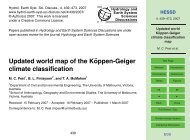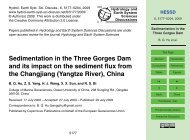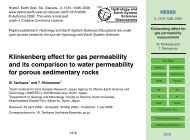In-situ evaluation of internal drainage in layered soils (Tukulu - hessd
In-situ evaluation of internal drainage in layered soils (Tukulu - hessd
In-situ evaluation of internal drainage in layered soils (Tukulu - hessd
Create successful ePaper yourself
Turn your PDF publications into a flip-book with our unique Google optimized e-Paper software.
5<br />
10<br />
15<br />
20<br />
25<br />
5<br />
10<br />
15<br />
20<br />
25<br />
their soil water release (SWR) and permeability is dependent on the structural and layer<strong>in</strong>g<br />
composition <strong>of</strong> the pr<strong>of</strong>iles diagnostic horizons. The SWR and permeability functions<br />
could be described by the SWR curve or soil water characteristic curve (SWCC)<br />
and unsaturated hydraulic conductivity (K -coefficient), respectively. While the former is<br />
expressed as a function <strong>of</strong> matrix suction (h) and SWC (θ) (Dane and Hopmans, 2002)<br />
the latter is expressed as a function <strong>of</strong> either h or θ (Ech<strong>in</strong>g and Hopmans, 1993).<br />
<strong>In</strong> practice <strong><strong>in</strong>ternal</strong> <strong>dra<strong>in</strong>age</strong> depicts the empty<strong>in</strong>g <strong>of</strong> water filled pores under the<br />
<strong>in</strong>fluence <strong>of</strong> gravity. <strong>In</strong> time and space, <strong>dra<strong>in</strong>age</strong> rate dim<strong>in</strong>ishes with SWC approach<strong>in</strong>g<br />
negligible levels once the <strong>dra<strong>in</strong>age</strong> upper limit (DUL) has been realised at about 0.1 to<br />
0.2 % per day (Ratliff et al., 1983). The DUL could further be reduced to approach the<br />
<strong>dra<strong>in</strong>age</strong> lower limit (DLL), equivalent to the permanent wilt<strong>in</strong>g po<strong>in</strong>t (Hillel, 2004), by<br />
evaporation or transpiration (Bennie et al., 1994). <strong>In</strong> most vertical <strong>soils</strong> DUL could be<br />
achieved between 2 to 12 days for f<strong>in</strong>e-textured <strong>soils</strong> and up to 20 days <strong>in</strong> <strong>soils</strong> with<br />
a restrictive layer (Ratliff et al., 1983). The difference between DUL and DLL represents<br />
the plant available water (PAW) that is important for estimat<strong>in</strong>g crop water requirements<br />
(Bennie et al., 1994; Bittelli and Flury, 2006). Therefore accurate measurement <strong>of</strong> the<br />
soil hydraulic functions that determ<strong>in</strong>es the extent at which soil water dra<strong>in</strong>s away from<br />
the pr<strong>of</strong>ile is crucial for effective soil water management.<br />
<strong>In</strong> <strong>situ</strong> <strong><strong>in</strong>ternal</strong> <strong>dra<strong>in</strong>age</strong> methods <strong>of</strong> determ<strong>in</strong><strong>in</strong>g soil hydraulic functions are considered<br />
to be more realistic than laboratory methods. Cont<strong>in</strong>uum <strong>of</strong> soil horizons represents<br />
the actual boundary conditions under which water flows <strong>in</strong> a composite pr<strong>of</strong>ile.<br />
<strong>In</strong>ternal <strong>dra<strong>in</strong>age</strong> under <strong>in</strong>-<strong>situ</strong> conditions was first studied by Richard et al. (1956).<br />
Difficulties <strong>in</strong> measurement <strong>of</strong> K -coefficient under <strong>in</strong>-<strong>situ</strong> conditions because <strong>of</strong> variations<br />
<strong>in</strong> humidity and the need for simultaneous measurement <strong>of</strong> many parameters,<br />
transient experiments were preferred from the beg<strong>in</strong>n<strong>in</strong>g. Early contributions <strong>in</strong>cluded<br />
work by <strong>of</strong> Nielsen et al. (1964), Rose et al. (1965) and Watson (1966) that culm<strong>in</strong>ated<br />
to the launch<strong>in</strong>g <strong>of</strong> the <strong>in</strong>stantaneous pr<strong>of</strong>ile method (IPM) (Hopmans et al.,<br />
2002). <strong>In</strong>version <strong>of</strong> the Richard flow equation provided means to estimate the K -<br />
coefficient (Vachaud and Dane, 2002) <strong>in</strong>directly from the ratio <strong>of</strong> <strong>dra<strong>in</strong>age</strong> flux and<br />
9799<br />
effective hydraulic gradient. Other <strong>in</strong>-<strong>situ</strong> methods are the <strong><strong>in</strong>ternal</strong> <strong>dra<strong>in</strong>age</strong> and zero<br />
flux plane methods described by Vachaud et al. (1978) and tension disk <strong>in</strong>filtrometers<br />
(Hopmans et al., 2002; Simunek et al., 1999). The IPM was consolidated when the<br />
<strong>in</strong>-<strong>situ</strong> procedure to calculate the K -coefficient was published by Hillel et al. (1972).<br />
Among earlier studies the unity gradient become popular but was later disputed by<br />
Richardts (1993); Bacchi and Richardts (1993). To keep pace with the advances <strong>in</strong><br />
the laboratory methods such as the one step (Kool et al., 1985) and multi-step (van<br />
Dam et al., 1994; Ech<strong>in</strong>g et al., 1994) outflow experiments, the IPM went through<br />
a series <strong>of</strong> modernization. This <strong>in</strong>cluded the computational contributions by Libardi<br />
et al. (1980) and Bacchi (1988), and the parameterization <strong>of</strong> the Richard <strong>in</strong>version by<br />
Richardts et al. (2004). The first to use parameters based models to <strong>in</strong>versely estimate<br />
soil hydraulic functions from <strong>in</strong>-<strong>situ</strong> experimental data was Dane and Hruska (1983),<br />
even though lack <strong>of</strong> uniqueness <strong>of</strong> their solution was a concern. Hurtado et al. (2005)<br />
used the IPM to estimate hydraulic functions below the DUL while Neto et al. (2007)<br />
<strong>in</strong>troduced computer based s<strong>of</strong>tware to calculate the K -coefficient <strong>in</strong> <strong><strong>in</strong>ternal</strong> <strong>dra<strong>in</strong>age</strong><br />
experiments.<br />
Despite the remarkable works done to improve <strong>in</strong>-<strong>situ</strong> <strong><strong>in</strong>ternal</strong> <strong>dra<strong>in</strong>age</strong> methods,<br />
laboratory transient experiments are still by far dom<strong>in</strong>ant. Better control <strong>of</strong> conditions<br />
and parameters <strong>in</strong>fluenc<strong>in</strong>g soil hydraulic functions as well as access to dynamic <strong>in</strong>strumentation<br />
and powerful computers has made laboratory experiments attractive. Transferr<strong>in</strong>g<br />
some <strong>of</strong> these technologies to develop<strong>in</strong>g farm<strong>in</strong>g communities has not been<br />
successful <strong>in</strong> many occasions. Nevertheless, approaches such as the pedo-transfer<br />
(Leij et al., 1996; Acutis and Donatelli, 2003) and hang<strong>in</strong>g water column technique<br />
(Vomicil, 1965; Dane and Hopmans, 2002) if used <strong>in</strong> collaboration with the IPM could<br />
serve as relatively cheap and yet powerful alternatives.<br />
<strong>In</strong> the Free State prov<strong>in</strong>ce <strong>of</strong> South Africa, most <strong>of</strong> the rural farmers are concentrated<br />
on the low agricultural potential areas predom<strong>in</strong>ated by <strong>layered</strong> <strong>soils</strong>. This group<br />
<strong>of</strong> <strong>soils</strong> belong to the Duplex land type (Soil Classification Work<strong>in</strong>g Group, 1991) and<br />
occupy more than 10 % <strong>of</strong> the prov<strong>in</strong>cial landscape (Hensley et al., 2006). Erratic soil<br />
9800<br />
Discussion Paper | Discussion Paper | Discussion Paper | Discussion Paper |<br />
Discussion Paper | Discussion Paper | Discussion Paper | Discussion Paper |







